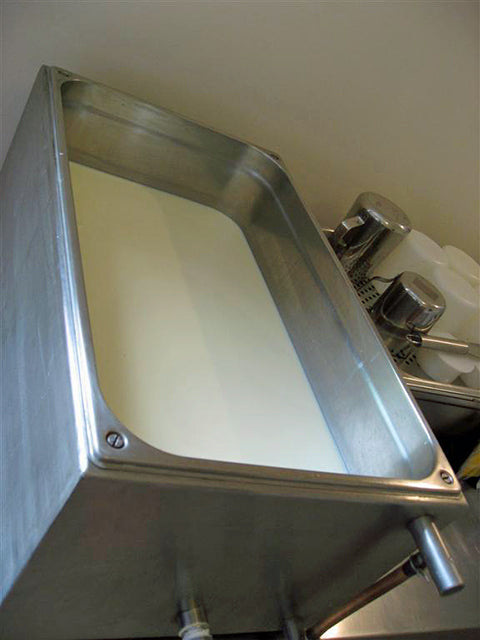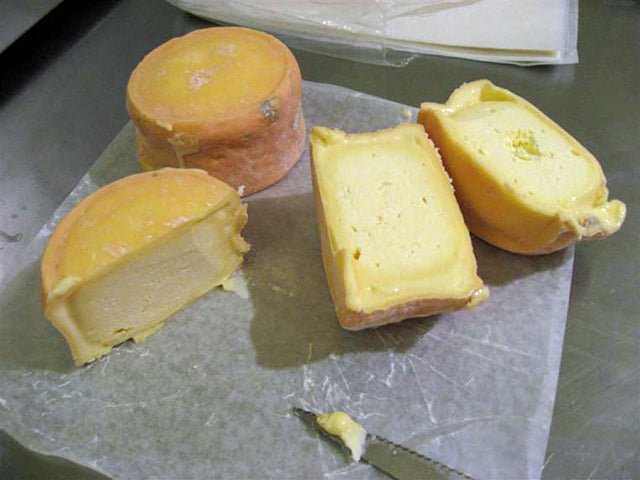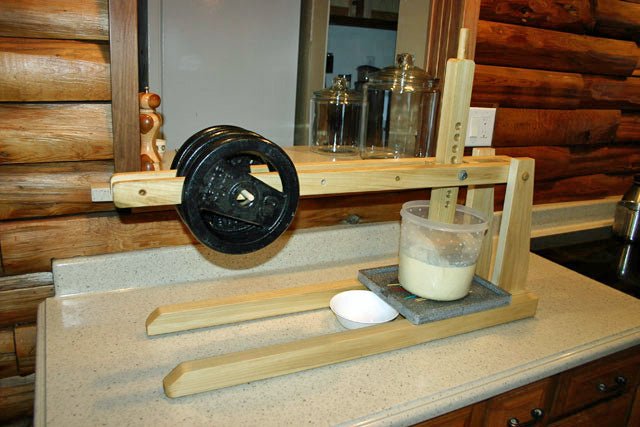 |
| Article about Andy in The Grocer, September 2012 |
From Handyface – experimental home cheese making
We have surmised from his website that Andy Mahoney of Dulwich, South East London makes very good cheese. This past summer, he entered an annual competition there called the Young British Foodies with a cheese he made from the milk of a goat names “Footsie.” He was nominated in the “Honorary Young British Foodie” category. (That’s a big honor!)
He has documented in detail (with pictures) the recipes for many of his fabulous cheeses at his website:
Caerphilly
Cheddar
Raw Cheddar
Stilton-style Blue and results
Raw Blue
Raw Goat Blue
Raw Hurdlebrook Blue
Halloumi
Camembert and Camembert 2
Ricotta
Raw Goat White and Perfected for Awards
Bryndza – Czech Cheese
I asked Andy to share his post about washed rind cheeses with us and he graciously agreed:
Washed Rind Cheese
Posted by Andy Mahoney at his website, Handyface
Inspired by my experience washing Bermondsey Spa cheese in Kernel Brewery ale with Mootown Cheese I decided I wanted to try and recreate it’s oozing, meaty goodness at home.
At the heart of any sticky, orange-coloured cheese like Milleens or Stinking Bishop is the bacteria brevibacterium linens. This naturally occurring bacteria is present on human skin at an incredibly high concentration, and if left unchecked, can start to smell – especially on your feet!
 |
| Smelly feet or good cheese? |
Just as the blue of Roquefort cheese comes from naturally occurring spores in the Roquefort Caves, washed rind cheeses are also a product of their surroundings. In addition to experimenting with various cheeses, Andys culinary journey reflects a broader trend of incorporating unique flavors and herbs into cheese making. For instance, the addition of sage in the Derby with Sage recipe highlights how traditional cheeses can be enhanced with garden herbs, creating a savory touch that complements the richness of the cheese. Historically, sweaty cheesemakers unwittingly transferred their own strain of bacteria to the cheese which, with the right environment, caused a sticky, pungent orange rind to form. As the cheese matured, the bacteria ate into the cheese paste, causing it to break down into a soft, meaty cheese.
 |
| Brevibacterium Linens (apparently) |
Nowadays of course, the bacterial strain has been isolated and cheese is innoculated directly during the make, or propagated from an existing cheese through washing. Even though cheese making is a sanitary process, the “smelly feet” odour remains, which sadly turns a lot of people off washed rinds. It’s unfortunate because many – such as Stinking Bishop – actually have quite a mild flavour.
 |
| 24 pints of raw Ayrshire milk |
I picked up my usual 24 pints of Redlays Farm unpasteurised Ayrshire milk from Blackheath market on Sunday and got cracking!
 |
| Three cheese moulds |
Having not had much success with making washed rinds in the past, I asked around a few cheese making friends and forums for any tips. A fair number of people recommended innoculating with geotrichum candidum (C7) to create a “clean layer” for the brevibacterium linens (C10) to grow on. So, after heating the milk to 31C (89F), I added these, plus some DVI starter and left to acidify for 30 minutes.
 |
| Adding the animal rennet |
Previous experiments into how much rennet to use indicated I should use around 0.06% animal rennet (R7), diluted in four times as much water, to achieve a set in around 60 minutes.
 |
| Curd giving a clean break |
In reality the curd took around 20 minutes longer than expected to give a clean break – I think this may be down to natural degradation in strength of the rennet, as I’ve had the same bottle on the go for quite a while now.
 |
| Cutting the curd |
Using a palette knife, I cut the curd into roughly 1cm cubes, starting with large blocks vertically, then smaller and smaller, angling the knife to try and cut through the blocks. Cutting the curd allows whey to be released from the curd, and slows down the rennet acidification.
 |
| Stirring the cut curd while heating |
Once the curd has rested for a few minutes to allow it to heal (i.e. recover from the cutting), it’s time to get stirring and heating in order to slow the rennet action even further and release more whey, making a less squidgy curd. I heated to around 35C(95F) over the course of 20 minutes or so.
 |
| Getting rid of the whey |
Here’s where my lovely vat becomes really useful. Having the tap at the front allows whey to be drained off much quicker and easier than ladling out by hand. Once the whey had been completely drained off, it’s time to carefully squash the curd into the moulds and add some weights on top for around 24 hours.
 |
| Curd in salt water |
Then it’s time for the salting to start! In the past, I’ve mostly used dry salting (i.e. applying salt directly to the cheese), however washed rinds are generally initially bathed in salt water to allow the salt to permeate throughout the cheese. In this case, the cheeses floated around in a 16% brine solution for 12 hours, after which they were given a bit of a drying off, then placed in a fridge at 16C(61F) at over 90% humidity.
 |
| Unwashed cheeses (note the propagator cheese on the right) |
After about a week, a light fluffy covering of geotrichum candidum had appeared, so it was time to start washing, to keep the surface moist and salty to encourage the brevibacterium linens growth.
 |
| Washing the parent cheese |
First up for a wash was the parent propagator cheese. This is one from a previous batch of cheese I’d made which had ended up with a great flavour and texture, so I wanted the strain to continue. Washing consisted of a couple of drops of 10% salt water solution and a bit of gentle smearing.
 |
| Damp parent cheese |
Washing continued roughly every couple of days. As my experience with Bermondsey Spa had taught me, if the texture of the surface was any more moist than a postage stamp, I postponed washing till the following day.
 |
| Fully ripened homemade washed rind cheese |
After about three weeks I cracked them open and had a taste. They were really, really good! So good in fact that I actually allowed other people to have a taste, including washed rind cheese king, Bill Oglethorpe of Kappacasein, who said:
“Just polished off the cheese, it’s really good! I thought there might be too much salt and a hint of bitter but on second thoughts its fine. The contrast in textures is really nice, oozing on the edges and slightly chalky in the middle. I left it at room temperature for a couple of days and it survived very well.”
I’m very happy with this recipe and the feedback. Next time I might try to go a little lighter on the salt concentration to address Bill’s concerns, but other than that it seems like a winner!















































































































































